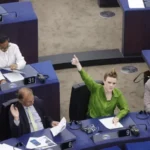Hendaye (France) – On a futuristic-looking machine, a used sneaker passes through a tunnel before being delicately grasped by an immense articulated arm which tears off its sole with force and precision: this operation, which seems benign, is in reality fundamental for the world of textile recycling.
The first innovation platform in the world to achieve this manipulation in an automated manner, Cetia, in Hendaye (south-west), opens the way to the remanufacturing of new soles from used ones. While Europe only knows how to recycle a tiny part of its textiles on an industrial scale (1%), players are mobilizing to structure a still embryonic sector, like Cetia which is developing pioneering solutions in preparation for recycling.
Currently, in Europe, shoes are disassembled manually or simply crushed. “We have filed two patents,” reveals Chloé Salmon Legagneur, director of Cetia. Initially a research chair at the Estia engineering school, Cetia – in partnership with the private research center CETI – is now a company offering innovative prototypes in textile and leather recycling.
Marilou Hargoues, a young engineer, manipulates a sneaker which gave the robot a hard time. “The difficulty is that there is foam” in the sole, the composition of which the manufacturers do not communicate, she comments. This complicates the calibration of the robot.
This project, called Re-shoes, is “essential”, believes Véronique Allaire-Spizer, director of the Regeneration division of the approved eco-organization Refashion: “as long as we do not have a preparation solution (material in view of its recycling), we will not have a sector” in France. The eco-organization injects 900,000 euros to finance projects in Cetia, the Nouvelle-Aquitaine Region almost a million.
Zips, buttons, rivets…
Currently, a major part of the 1% of recycled textiles in Europe does not make it possible to remanufacture yarn but is transformed into insulation, padding, bitumen… However, by 2030, the European Union intends to set “a content minimum of recycled fibers in the composition of textiles”, according to the Commission website. The challenge is therefore to achieve an industrial solution which allows for a fairly fine sorting of the material and a delicate enough dismantling to make clothes from clothes again.
The Cetia machine, which recognizes the color and composition of the fabric when two materials are mixed using infrared technology, is therefore decisive in preparation for recycling. The sorted clothes pass through another machine which separates “hard points” (zips, buttons, etc.) from the fabric. The material that emerges therefore has a known composition and is more easily reusable.
Further in the hall, another machine with laser cutting ensures that the fabric is not damaged when separating the fabric from the other components. It is of particular interest to the luxury sector which needs to keep its noble materials intact.
Another, using artificial intelligence, knows how to distinguish a pocket from a collar, a sleeve from a pant leg, an essential differentiation when it comes to carrying out an initial sorting before recycling.
This cutting-edge equipment is worth nearly 2 million euros. “Brands tell us: ‘I want the material in my products to be able to be recycled in my industry and not in insulation or flooring,’” says the director of Cetia.
To facilitate recycling, certain brands including Decathlon – one of the first supporters of Cetia – think from the design stage “on the number of materials used, the disruptive elements, etc.”, explains Clémence Goubet, responsible for sustainable development of shoes within the sports brand, which is aiming for 100% eco-designed products in 2026.
The issue of recycling is also political: 200,000 tonnes of French textile waste are exported each year, for lack of a national solution, Cetia figures. “We have a deposit that is there, that we need to treat. Recycling can be a big contribution” to France’s reindustrialization file, underlines Chloé Salmon Legagneur. (AFP)
This article is originally published on fashionunited.fr







